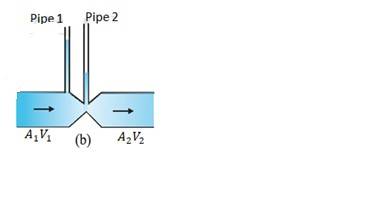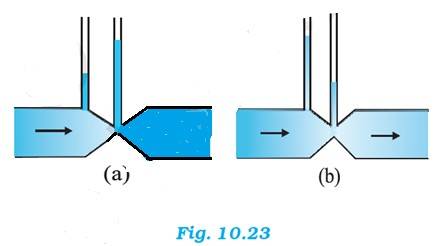Class 11th
Get insights from 8k questions on Class 11th, answered by students, alumni, and experts. You may also ask and answer any question you like about Class 11th
Follow Ask QuestionQuestions
Discussions
Active Users
Followers
New answer posted
6 months agoContributor-Level 10
Area of cross-section of the spray pump, = 8 = 8
Number of holes, n = 40
Diameter of each hole, d = 1 mm = 1 m
Radius of each hole, r = d/2 = 0.5 m
Area of cross-section of each hole, a = =
Total area of 40 holes, = 40 = 3.14
Speed of liquid inside the tube, = 1.5 m/min = 0.025 m/s
Speed of ejection of liquid =
According to law of continuity, we have = or =
= 0.637 m/s
New answer posted
6 months agoContributor-Level 10
Take the case given in figure (b)

= Area of pipe 1, = Area of pipe 2, = Speed of fluid in pipe 1, = Speed of fluid in pipe 2
From the law of continuity, we have
=
When the area of cross-section in the middle of the venturimeter is small, the speed of the flow of liquid through this part is more. According to Bernoulli's principle, if speed is more, the pressure is less. Pressure is directly proportional to height, hence the level of water in pipe 2 is less. Therefore, figure (a) is not possible.
New answer posted
6 months agoContributor-Level 10
Speed of the wind on the upper surface of the wing, = 70 m/s
Speed of the wind on the lower surface of the wing, = 63 m/s
Area of the wing, A = 2.5
Density of air, = 1.3 kg/
According to Bernoulli's theorem, we have the relation:
+ = +
( - )= - , where = pressure on the upper surface of the wing and - pressure on the lower surface of the wing
The pressure difference provides lift to the aeroplane
Lift on the wing = ( - )A = - A = - N =
New answer posted
6 months agoContributor-Level 10
11.19 (a) A body with a large reflectivity is a bad absorber. A bad absorber will in turn be a poor emitter of radiations.
(b) Brass is a good conductor of heat, when one touches a brass tumbler, heat is conducted from the body to the brass tumbler easily. Hence, the temperature of the body reduces to a colder value and one feels cold.
On the other hand, wood is a poor conductor of heat. Very little heat is conducted from the body to the wooden tray. Resulting in negligible drop in body temperature.
Thus a brass tumbler feels colder than a wooden tray on a chilly day.
(c) Black body radiation equation is given by:
E = ( &nbs
New answer posted
6 months agoContributor-Level 10
Length of the horizontal tube, l = 1.5 m
Radius of the tube, r = 1 cm = 0.01 m
Diameter of the tube, d = 2r = 0.02m
Glycerine mass flow rate, M = 4 kg/s
Density of glycerine, = 1.3 kg
Viscosity of glycerine, = 0.83 Pa-s
Now, volume of glycerine flowing per sec V = = /s = 3.08 /s
According to Poiseville's formula, we know the flow rate
V = where p is the pressure difference between two ends of the tube
p = = = 976.47 Pa
Reynolds's number is given by the relation
Re = = = 0.3
Since the Reynolds's number is 0
New answer posted
6 months agoContributor-Level 10
It does not matter if one uses gauge pressure, instead of absolute pressure while applying Bernoulli's equation. There should be significantly different atmospheric pressures, where Bernoulli's equation is applied.
New answer posted
6 months agoContributor-Level 10
11.18 Base area of the boiler, A = 0.15 m2
Thickness of the boiler, l = 1.0 cm = 0.01 m
Boiling rate of water, R = 6.0 kg/min
Let us assume the mass of the boiling water, m = 6 kg and the time to boil, t = 1 min = 60 s
Thermal conductivity of brass, K = 109 J s–1 m–1 K–1
The amount of heat flowing into water through the brass base of the boiler is given by:
= , where
= Flame temperature in contact with the boiler
= Boiling point of water = 100
Heat required for boiling water = mL, where L = heat of vaporization of water = 2256 * 103 J kg–1
By equating for we get
6 = 109&n
New answer posted
6 months agoContributor-Level 10
No, Bernoulli's equation cannot be used to describe the flow of water through a rapid in a river. In rapid, the flow is turbulent whereas Bernoulli's equation is applicable for laminar flow only.
New answer posted
6 months agoContributor-Level 10
11.17 Size of the sides of cubical ice box, s = 30 cm =0.3 m
Thickness of the icebox, l = 5 cm = 0.05 m
Mass of ice kept in the box, m = 4 kg
Time gap, t = 6 h = 6 s
Outside temperature, T = 45 °C
Coefficient of thermal conductivity of thermocole, K = 0.01 J
Heat of fusion of water, L = 335 J
Let m' be the mass of the ice melts in 6 h
The amount of heat lost by the food: = , where
A = Surface area of the box = 6 = 6 = 0.54
= = 104976 J
We also know so m' = 104976/ (335 = 0.313 kg
Hence the amount of ice remains after 6 h = 4
New answer posted
6 months agoContributor-Level 10
Height of the spirit column, = 12.5 + 15 cm = 27.5 cm
Height of the water column, = 10 + 15 cm = 25 cm
Density of spirit, = 0.8 gm/
Density of water, = 1 gm/
Density of mercury, = 13.6 gm/
Let h be the difference between the levels of mercury in two limbs
Pressure exerted by mercury column of h height= h = 13.6hg …. (i)
Difference between pressure exerted by water and spirit columns:
= 3g ……. (ii)
Equating equations (i) and (ii), we get
13.6hg = 3g
h = 3/13.6 = 0.221 cm
Taking an Exam? Selecting a College?
Get authentic answers from experts, students and alumni that you won't find anywhere else
Sign Up on ShikshaOn Shiksha, get access to
- 65k Colleges
- 1.2k Exams
- 679k Reviews
- 1800k Answers

